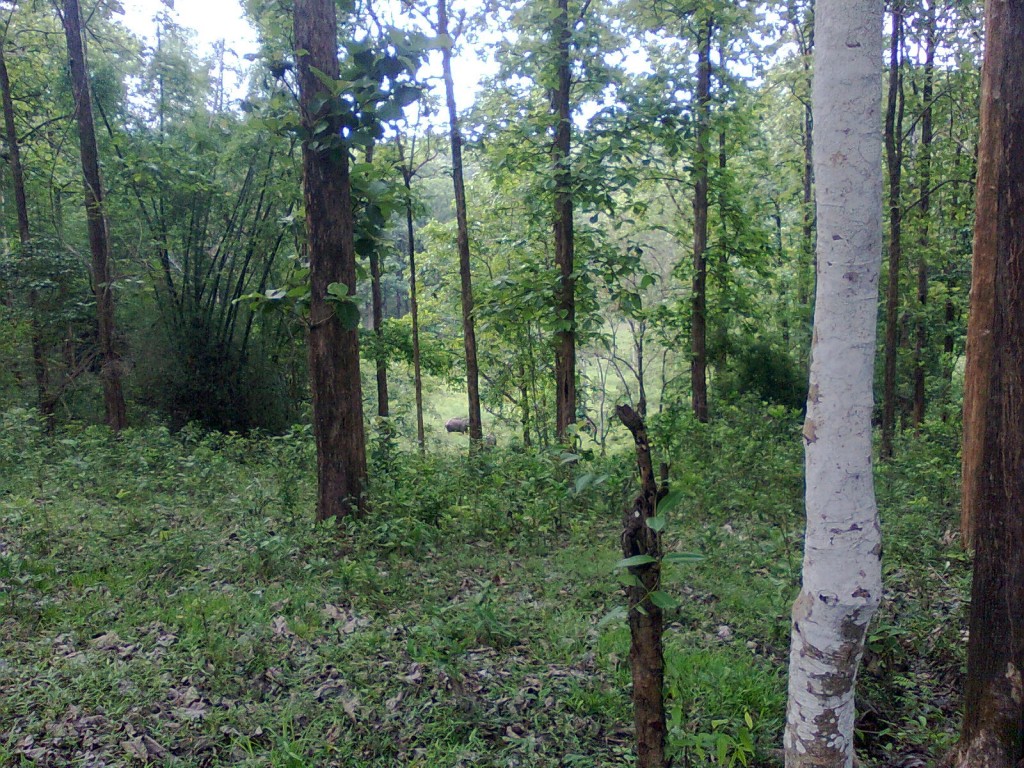We arrived bright and early at the Sethumadai Checkpost, the entry point to the Indira Gandhi Sanctuary, but the weather refused to reflect our enthusiasm: almost at once, it started to rain. The guard too was disinterested in us: after performing his morning ablutions for a good half an hour, he finally opened the gates and we entered the forests of Annamalai, literally ‘Elephant Hill’.
Bad weather followed us in and the light rain soon strengthened into a steady drizzle. At the Annapady Checkpost, a couple of kilometres away, the guard lifted the barrier and we were in Kerala once again. A guide from the indigenous community joined us here. “You have chosen a bad day to visit Parambikulam Tiger Reserve,” he informed us cheerfully as soon as he settled down in the jeep. “You aren’t likely to see anything in this rain.” He sufficiently dampened our spirits, but soon seemed to take pity on us, for, he added, “Though you may not see bigger animals like elephants and gaur, you just might come across a leopard, or even the tiger! Who knows?” Who knows indeed!
A few minutes later, as we turned a bend in the road, we almost bumped into a huge male gaur. I have seen gaur in Madhya Pradesh, but those animals are slim and small compared to the huge specimens one comes across in the forests of Kerala and Karnataka. The animal in front of us was incredibly big. Behind him, in the still dark forest pillared with teak trees, there was a whole herd of gaur, with females and calves. The male, whom we had caught trying to cross the road, snorted and turned back the way he had come, and without any hurry retreated into the woods, from where he continued to gaze at us. The rest of the herd followed suit, gradually melting into the forest. It was a good start to our expedition.
A couple of kilometres later, we came across a small herd of elephants. There were around eight animals in the herd, including a very small calf. As soon as we stopped, the herd bunched together, with the calf in the middle, and the adult females stared belligerently at us. A few minutes later, we came across yet another elephant, a makhna (tusk-less male), and the guide whispered that the jeep wasn’t to be stopped: this one was trouble, a very ill-tempered beast liable to charge without provocation. We did not stop, and instead merely slowed down. The makhna was irritated all the same. He shook his head violently and thumped the earth with his curled trunk. But thankfully, instead of charging, he trumpeted loudly and crashed back into the thicket.
Our day brightened up considerably but the drizzle did not stop. We saw herds of spotted deer grazing on either side of the road as we drove towards Thunakadavu. They were not a bit nervous as we stopped to watch them. In fact, they seemed habituated to humans. At Thunakadavu, we stopped at the Inspection Bungalow and enjoyed the marvellous view of the lake. As it stopped raining and a mild sun came out, we saw gaur out for a drink on the farther bank of the lake.
Next on our itinerary was a stop at the Kannimara teak, considered the largest and perhaps the oldest teak tree in the world. The path to the tree traverses marshlands, and we saw a herd of gaur — more skittish animals this time, fleeing at our approach — and a short distance away from the teak tree, the flapping ears of a couple of elephants. “There is a whole herd there,” our guide whispered. “It is better not to go any closer.” Clearly, there was no argument there! We retreated to our jeep as quickly and silently as possible and headed back.
We had spent only six hours in the sanctuary and, in that short time, the wildlife viewing had been exceptional, though the weather had been decidedly unfriendly and photography all but impossible. We had also seen an abundance of bird life, and most importantly, the rare black woodpecker perched on the trunk of a tree. Of course, all thanks to the rain, I don’t have a picture to prove it!
About Parambikulam Wildlife Sanctuary
Parambikulam Wildlife Sanctuary is Kerala’s third biggest wildlife sanctuary. It was once a small reserve forest of 48 sq km, but it was expanded in 1962. At one time, teak trees were grown in the area, but today, the sanctuary is managed in such a way that the forest retains its natural status. About 9,000 hectares of teak plantations can be found in Parambikulam. There are three dams inside Parambikulam, and the Kerala Government has plans to launch another hydroelectric project in the area. Environmentalists fear that this would destroy the forest, and also come in the way of uninterrupted elephant movement from Parambikulam to the forests around. Forest fires too occur, usually between January and April, causing damage to the park.
Quick Facts
State: Kerala
Location: Running contiguous to the Indira Gandhi Wildlife Sanctuary, Parambikulam is situated in the Annamalai Hills of the Western Ghats, south of the Palakkad Gap, in Kerala’s Palakkad District, bordering Tamil Nadu Distances 267 km NE of Kochi, 119 km SW of Coimbatore, 107 km SW of Palakkad Route from Kochi NH47A and NH47 to Palakkad via Aluva, Angamali, Chalakudy, Thrissur and Alathur; state roads to Annapady Checkpost via Sethumadai and Top Slip
When to go: The best time to visit is from Sep to Jan. The forests are dry from Feb onwards and the sanctuary is closed during the summer months for fear of forest fires; the dates are usually announced just a few days before closure. Check with the Information Centre (see below) before making your plans
Go there for Elephants, gaurs, tigers
About the Author
A college teacher by profession, S Vinaya Kumar lives and teaches in Thiruvananthapuram, and does photography as a hobby.






